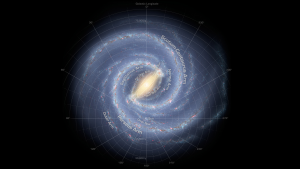BLAST-TNG Observations of Molecular Clouds in the Galactic Plane of the Milky Way/ Giant Molecular Clouds
One of the most important questions in understanding star formation is understanding the role that magnetic fields play in shaping the densest parts of the interstellar medium: The giant molecular clouds (GMCs) that lie on the Galactic plane of the Milky Way Galaxy.

Figure 1. An artist’s impression of how the spiral arms of the Milky Way Galaxy would look if we could see our own galaxy from the outside (https://www.nasa.gov/jpl/charting-the-milky-way-from-the-inside-out). This graphic has been put together from the work of Carmago and team, from Brazil (https://arxiv.org/abs/1505.01829; http://adsabs.harvard.edu/abs/2015MNRAS.450.4150C)
The gas in the spiral arms of the Milky Way Galaxy is only around 10-times more dense than that in the inter-spiral arms, but as Figure 1 shows, these spiral arms light up due to the massive O and B stars that form in this dense gas. These stars pump out enormous amounts of ultraviolet (UV) radiation, heating the surrounding gas to several thousand degrees, causing the reddish and (indirectly) the blueish light we can see in Figure 1, that delineates the spiral arms.
These massive stars drive the evolution of the Milky Way Galaxy, by virtue of the enormous amount of energy they pump into the surrounding gas. In fact, stars of this type drive the evolution of all galaxies, and so understanding how magnetic fields in Spiral Arm GMCs affects star formation in the Milky Way galaxy provides a valuable link between understanding star formation locally, as in the Vela C molecular cloud (link to this website’s local star formation page), and understanding star formation throughout the Universe, as in the extragalactic projects (add link to this BLAST-TNG project).
Choosing Spiral Arm GMCs in which to measure magnetic fields requires very careful selection. GMCs are often coincident with other collections of dense gas along the line of sight from the Earth to the targeted GMC (again, see Figure 1: Imagine you are at the position of the Sun, looking at GMCs through the different spiral arms). Eliminating this line-of-sight confusion requires choosing GMCs that either do not have other clouds/ CMCs in front of or behind them, or for which confusing line of sight clouds can be easily eliminated due to their very different velocity. We are using, among other surveys, the ThrUMMS survey (http://www.abc.net.au/news/2015-10-21/milky-way-galaxy-star-forming-clouds/6861712; https://arxiv.org/abs/1507.05095) of the Southern Galactic plane to choose suitable BLAST-TNG GMC targets, uncontaminated by fore or background emission.




